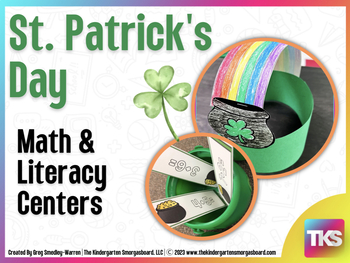St. Patrick's Day Math and Literacy Centers
Kindergarten Smorgasboard
37.8k Followers
Grade Levels
PreK - 1st
Subjects
Resource Type
Standards
CCSSK.CC.A.1
CCSSK.CC.A.2
CCSSK.CC.A.3
CCSSK.CC.B.4
CCSSK.CC.B.5
Formats Included
- PDF
Pages
195 pages
Kindergarten Smorgasboard
37.8k Followers
What educators are saying
This resource was a wonderful supplement to our regular curriculum. I was able to use it with a preschooler and kindergartener because of the variety of activities. Thanks!
The spinners are a huge hit with kindergartners. It gives them opportunities for cooperative learning as well as number practice!
Description
Celebrate St. Patrick’s Day in your classroom with these 7 math and 8 literacy centers! These hands-on, engaging, differentiated centers provide over 100 pages of learning fun!
Includes:
- Ten Frame Puzzles
- Spin and Add (to 10)
- Spin and Subtract (to 10)
- Addition to 10
- Subtraction to 10
- Spin and Count
- Tally Mark Puzzles
- Number Order to 100
- CVC Word Puzzles
- CVC Word Building
- CVC-E Word Puzzles
- CVC-E Word Building
- Beginning Sounds Matching
- Middle Sounds Sorting
- Final Sounds Sorting
- Write the Room
- BONUS: Rainbow Hat Craftivity
Please be sure to check out our website to read our blog, download freebies & handouts in the Resource Center, see where Mr. Greg will be making appearances in the Events tab, and more. Visit our website here: The Kindergarten Smorgasboard
Thank you!
Greg & Jason Warren
kindersmorgie@gmail.com
Total Pages
195 pages
Answer Key
N/A
Teaching Duration
2 Weeks
Report this resource to TPT
Reported resources will be reviewed by our team. Report this resource to let us know if this resource violates TPT’s content guidelines.
Standards
to see state-specific standards (only available in the US).
CCSSK.CC.A.1
Count to 100 by ones and by tens.
CCSSK.CC.A.2
Count forward beginning from a given number within the known sequence (instead of having to begin at 1).
CCSSK.CC.A.3
Write numbers from 0 to 20. Represent a number of objects with a written numeral 0-20 (with 0 representing a count of no objects).
CCSSK.CC.B.4
Understand the relationship between numbers and quantities; connect counting to cardinality.
CCSSK.CC.B.5
Count to answer “how many?” questions about as many as 20 things arranged in a line, a rectangular array, or a circle, or as many as 10 things in a scattered configuration; given a number from 1-20, count out that many objects.





